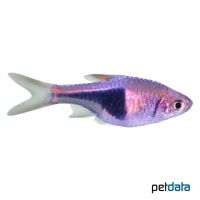Harlequin Rasbora (Trigonostigma heteromorpha)
| Harlequin Rasbora Trigonostigma heteromorpha | |
|---|---|
| Name | Harlequin Rasbora |
| Name Lat. | Trigonostigma heteromorpha |
| Synonym | Rasbora heteromorpha |
| Family | Danios |
| Family lat. | Danionidae |
| Order | Carps |
| Order lat. | Cypriniformes |
| Origin | Southeast Asia |
| Habitat | Forest streams, ponds |
| Diet | Carnivore |
| pH | 5.0-7.5 |
| Behavior | Peaceful |
| Keeping | Group |
| Care Level | Moderate |
| Reproduction | Substrate spawner |
| Breeding | Difficult |
| Life Span | 4-6 years |
| Protection | No |
| Metric Units | |
| Size | 4-5 cm |
| Temperature | 21-28 °C |
| Hardness | < 12 °dH |
| Aquarium | ~ 60 l |
| US Units | |
| Size | 1.6"-2" |
| Temperature | 70-82 °F |
| Hardness | < 214 ppm |
| Aquarium | ~ 15 gal |
Distribution and habitat
The wedge spotted danios are widespread in the south of Thailand, the Malay Peninsula as well as on Sumatra and Borneo. They live in weedy pools and in slow-flowing, shady forest streams with dense underwater vegetation and clear, slightly acidic water.
Maintenance
The aquarium should have a varied planting (mainly Cryptocorynen), which offers both shelters, as well as swimming space and roots, which serve as a retreat. With shaded light (floating plants) and a dark substrate covered with some foliage (sea almond leaves) they show the most beautiful coloration.
No ammonia, ammonium and nitrite should be detectable, the nitrate value should not exceed 100 mg/l. To ensure the water quality and oxygen content, a filter and heater adapted to the aquarium size is required, as well as lighting for the species-appropriate day-night rhythm of the animals.
Diet
In nature they feed on insects, insect larvae and plankton. The food supply consists of live, frozen and dry food. For a balanced diet, feed once a day with a high-quality, protein-rich dry food (flakes, granules, pellets) as well as cyclops, moina, daphnia, artemia, etc. (live or frozen)
It is recommended to feed small portions several times a day. Only feed as much as will be eaten within a few minutes. A regular and varied diet promotes health and increases resistance.
Behaviour and compatibility
They are lively and very peaceful schooling fish that can be socialized well with other small, peaceful fish. At least 5, but preferably much more Keilfleckbärblinge should be kept together.
Basically, only compatible fish species with similar requirements for water conditions and water temperature should be socialized.
Sex dimorphism
The wedge spot tends to run straight out in the male, while it is curved in the female.
Reproduction and breeding
The male usually swims around (drifts) the female in the early morning, which spawns on the underside of aquatic plant leaves, preferably Cryptocorynes. The parents do not engage in brood care and should be separated from the fry after spawning, as they are spawn predators. The larvae hatch after about 24 hours and swim freely after one week
Fry must be fed several times a day with special rearing food (Artemia nauplii, dust food). In a community tank breeding is hardly possible, because the spawn is easy prey.
Important
Wedge spot danios are bred in several color variations.
The foliage (sea almond tree, oak, etc.) enriches the water with humic substances, naturally lowers the PH value and is a valuable secondary food source.
The well-being of the fish should be checked regularly. Temperature should be checked daily, pH, hardness and nitrate levels should be checked at least every 14 days. Regular partial water changes are recommended, even when contaminant levels have not yet reached the upper limit. Sudden changes in water quality should be avoided. Newly introduced fish must be accustomed slowly to the water in the aquarium.
Further literature can be found in your pet store.
References
Text: Werner Winter; Image: petdata
Source: BMEL (1998): Tierschutzgutachten - Haltung von Zierfischen (Süßwasser); RIEHL & BAENSCH (2006): Aquarien Atlas Bd. 1, Mergus Verlag; ENGELMANN (2005): Zootierhaltung - Tiere in menschlicher Obhut: Fische, Verlag Harri Deutsch
- Gemäß § 21 Abs. 5 Tierschutzgesetz idgF
